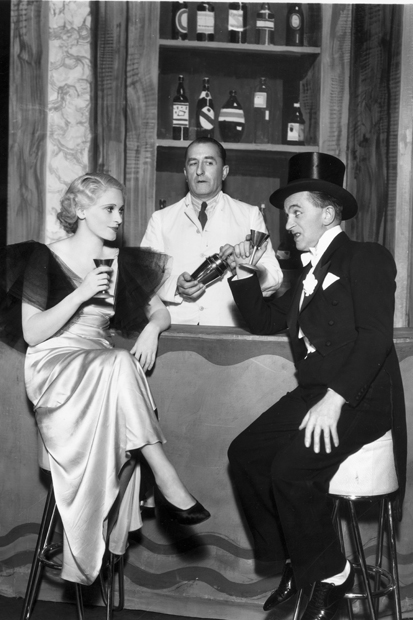Head upstairs. That’s my tip for thirsty play-goers during the interval. Most West End theatres are sunken affairs built in scooped-out craters, and this quirk of their design places the stalls 20 feet beneath the earth’s crust (hence the belly-rumble of Tube trains that wakens sleepy-heads during Twelfth Night or The Winter’s Tale). So the stalls bar is invariably a cramped dungeon with flock wallpaper and a ventilation system that pipes fresh air in from the Gents. Up a flight or two, you’ll find lightness, space and perhaps a view. But it seems that bunkers are now the first option of theatre architects.
The Old Vic’s basement bar has been given the full SM treatment. Hot light bulbs glare angrily at sweating walls and stag-beetle black tiles. If you’re not wearing studded lederhosen and a gimp-mask you’ll feel out of place. Three jollier bars await you higher up, including a champagne booth at street level for show-offs. The Royal Court has also opted for the panic-room effect downstairs. And the Young Vic has turned its entire bar area into a concrete sock drawer. It’s like entering an unlit squash court full of pretentious dossers high on Benzedrine and scrumpy.
But it’s easy enough to create a theatre bar that pleases those who use it rather than the Bauhaus community who never will. A high ceiling relaxes the spirits. A carpet absorbs the hue and cry of jabbering play-goers. Ornamental plasterwork, or some other visual distraction, makes a restful complement to a ten-minute glass of Merlot. Scatter some mismatched chairs in the corner and you’re there. Yet very few theatres boast all these amenities. My favourite is the Vaudeville on the Strand whose roomy upstairs bar has a dark crannyish enclave at the far end that offers views over the mobs bustling below. The house red is one of the best in London — but a health warning: it’s rather sweet and I love a big glass of sugary liquor as it makes quite a good meal. The National, boringly enough, meets the basic requirements. Breadth, height, a carpet, eccentric seating, and a view of the far-off twinkling Thames. And the prices aren’t too high.
It’s a common complaint that tariffs in West End bars make the mansion tax seem reasonable but the impresarios, trust me, are not out to fleece us. Think about it. The square foot of flooring that supports your Hush Puppies is one of the costliest pieces of real estate in the country. The prices have to meet the investment required to put the bar there at all. If you don’t like it, bring a liquid picnic. The hip-flask our grandparents relied on has been replaced by the recycled 500ml Evian bottle filled with Tesco’s white rum. This may not be the most romantic option for a first date, but if by a happy chance your companion uses the same refuelling system you may have found your soulmate. Until cirrhosis bags another brace.
London boasts two world-beating bars. At the Jermyn Street Theatre you’ll find one of the tiniest boozers on the planet: it’s a serving hatch on a bend in the staircase. And the Trafalgar Studios’ downstairs bevvy-bunker is an absolute triumph of botched spatial awareness. The blue carpet makes it look like a failed shoe-shop, and the rest is a neurotic warren of glass doors, angular pillars, inexplicable steps and superfluous mirroring. It’s almost worth going just to laugh. But not quite.
After the curtain call, as you exit the theatre filled with art and emptied of cash, you may find yourself in the banana curve of Shaftesbury Avenue. You’ve reached the devil’s canyon, a snorting, honking gulley of eye-watering neon billboards and nuked chicken outlets. Notice the shifting population of mechanised refugees. Squads of bewildered Koreans weave to and fro between Spanish rickshaw jockeys, kerb-crawling London cabbies, and the occasional ‘famous red bus’ dragging its domed buttocks towards some elephant’s graveyard. Not a place for a peaceful drink. Nor is Soho, nearby, where the rioting, coke-flecked pubs spill their human guts out onto the pavement. The Poetry Place, in secluded Betterton Street, may be short of atmosphere but it’s sepulchre-quiet, and the wine, about £15 a bottle, is a notch above what a tramp would find acceptable.
The Groucho, in Dean Street, is civilised and reasonably priced, if a little behind the times these days, and it welcomes non-members who know the doorway drill. ‘I’m meeting John Lloyd and Stephen Fry’ is your Open Sesame: if one of them isn’t inside, the other will be. Act coolly surprised if challenged, ‘I’m slightly late, can I pop in and check?’ Only a very rash gate-keeper would risk the ire of a celebrity member by quizzing you further.
Slightly less hassle is the Arts Theatre, on teeny-weeny Upper St Martin’s Lane, a few steps from Leicester Square. The theatre bar at street level is open to anyone, ticket-holder or not, and it has the unkempt ragamuffin air of a members-only establishment. Sixty years ago that’s what it was. To thwart the censor, the theatre posed as a club and required play-goers to sign a chunky registration book and buy a membership card rather than a ticket. Waiting for Godot, directed by Peter Hall, premiered here in 1955. Bernard Levin called it ‘a remarkable piece of twaddle’. The grubby bar features toad-stool perches and obese PVC banquettes that squeak when you move. It’s seldom busy because the owners have an admirable disdain for the buccaneering greed of most West End venues. They put on all kinds of stuff, mostly for fun, it seems, rather than profit. The wine list is commendably small and your drink will be poured into a plastic half-pint goblet whose blue-grey film no detergent can expunge. If you want a quiet and faintly sleazy Chardonnay after the show you couldn’t do better. Some cheapskates even pretend the place is their ‘London club’, but I have so far resisted such an imposture. Well, at least since I turned 50.







Comments